The 2014 Razer Blade Review
by Brett Howse on October 10, 2014 9:00 AM EST- Posted in
- Notebooks
- Gaming
- Laptops
- Razer Blade
Display
The 2013 Razer Blade was a fine system, offering reasonable battery life, reasonable weight, and good gaming performance all in an attractive aluminum package. The one stand-out flaw was the display. 1600x900 was a reasonable resolution for the GPU in the device, but the quality of the TN panel was, well, atrocious. Razer has gone all out to correct this glaring flaw for this year, offering a stunning 14 inch panel from Sharp.
The 3200x1800 panel in the new Razer Blade is easily one of its defining features. It features 262 pixels per inch, and to counter the higher power draw required of high PPI panels, they have implemented an indium gallium zinc oxide (IGZO) thin film transistor (TFT) for the panel, which allows a full RGB stripe but keeps the power requirements of the backlight in check because the IGZO TFT is thinner than traditional amorphous silicon TFTs. Lower cost panels such as the Lenovo Yoga 2 Pro use RGBW, with the white pixel to improve the transmission of light through the panel. IGZO is a better solution for image quality and color accuracy.
The 2013 Blade featured a twisted nematic (TN) panel, and it was far from the best TN panel available. It suffered from horrible viewing angles and very poor contrast. Luckily the new panel is either an in-plane switching (IPS) LCD or possibly Sharp's UV²A which is a form of ASV panel. There is not a lot of info out there for this exact panel, but the viewing angle problem is gone. IPS and MVA panels can be a bit slower than TN panels, but I did not notice any ghosting with this panel during gaming. Also, the new Blade features 10-point multi-touch.
High DPI panels have been discussed a lot, and while not every program is perfect on a high DPI windows laptop, the app gap has certainly closed. Major applications have taken a while to get updated, but we are now at the point where the benefits of a high DPI display outweigh the negatives. Google Chrome, long notorious for horrible high DPI support, has now been updated, and just recently Adobe has also updated their applications with high DPI support. Day to day use is no longer an issue, but if you still have an old program that will not run well on a high DPI display, there is always the option of lowering the resolution to 1600x900 (or even running at 1080p if you don't mind the non-integer scaling).
Moving on to display testing, let's look at the characteristics of this display and see how accurate it is out of the box as well as calibrated. This may not be a laptop designed for image professionals, but an accurate display is always good to have. Razer has gone to the length of including a default color profile for this laptop called Blade.icm. This should mean that some attention to detail was paid to the accuracy of the display, which is a good sign.
To test the display, we use the CalMAN 5 software suite with a custom workflow. An X-Rite i1 Display Pro is used for contrast readings, and an X-Rite i1Pro spectrophotometer is used to perform the grayscale and color accuracy.
Uncalibrated with default Blade.icm profile

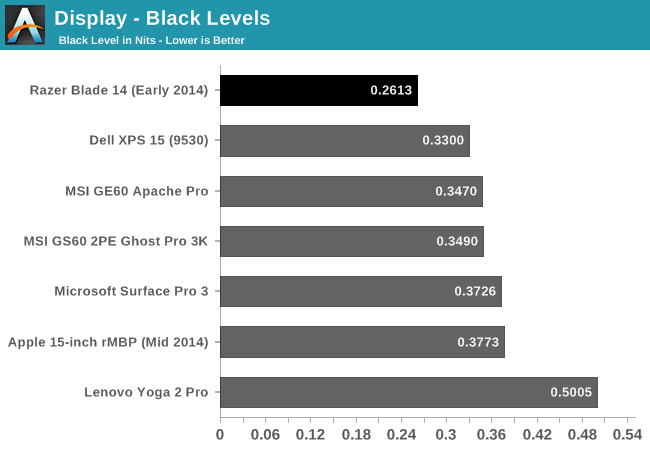
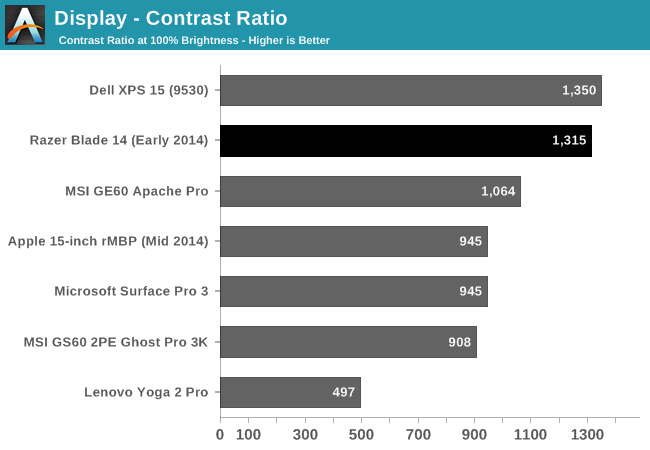
Razer rates the Blade at up to 400 nits of brightness, but the sample I received was not quite able to achieve that level even with the default profile bypassed. Still, 343 nits is a decent result and plenty bright for most environments. The black levels on the other hand are fantastic, which leads to one of the highest contrast ratios for any laptop we have tested.
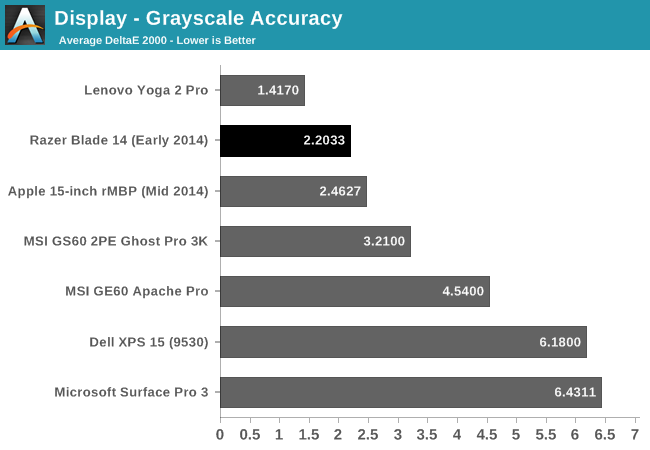
The white point is almost perfect out of the box. The grayscale is also excellent, though somehow the Yoga 2 Pro manages better with an RGBW display.
The blue values are a bit oversaturated on the sweeps, but once again the Razer Blade has a fantastic result, basically tied with the Retina MacBook Pro for the best we have tested.
Once again, the Razer Blade scores the best of any device we have tested.
This is an impressive display out of the box. The default color profile is excellent and the Razer Blade has basically the best display of any laptop we have tested. The one potential issue is the blue saturation is high, but it is a great result nonetheless.
As good as the display is with a default profile, we can still calibrate it using the CalMAN software to see if we can do better.
Calibrated
Calibrating for sRBG and Gamma 2.2, the results are nothing short of fantastic. Grayscale is an amazing 0.5177, the saturation drops to 1.1976 and GMB is 1.0426. The only issue is still with the blue being slightly oversaturated. 100% blue has a Delta E of around 5, but other than that the rest of the results are excellent.
The 2013 Razer Blade had an amazingly bad display, and it looks like Razer learned from that and not only did they put in a good display, they put in a fantastic display. At 262 PPI, it is higher density than the Retina MacBook Pro, and the panel delivers fantastic, colors, contrast, and grayscale out of the box.


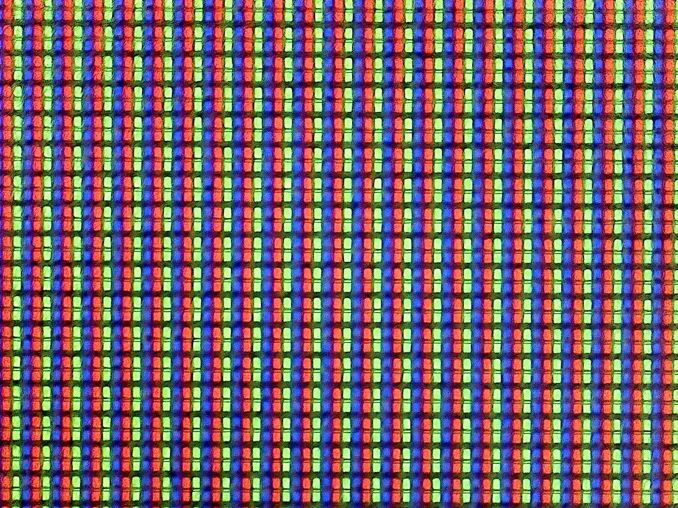

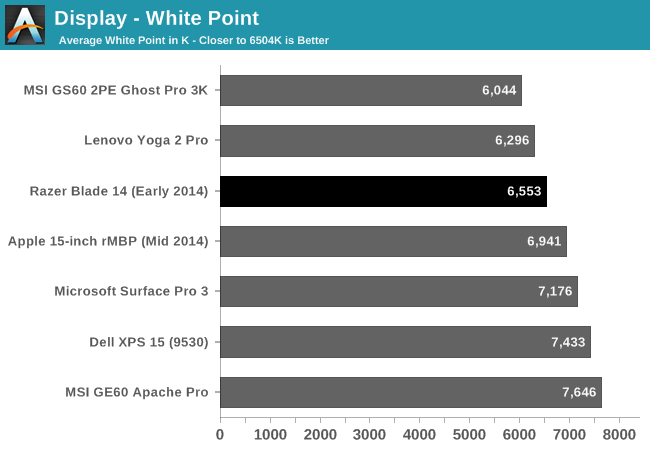

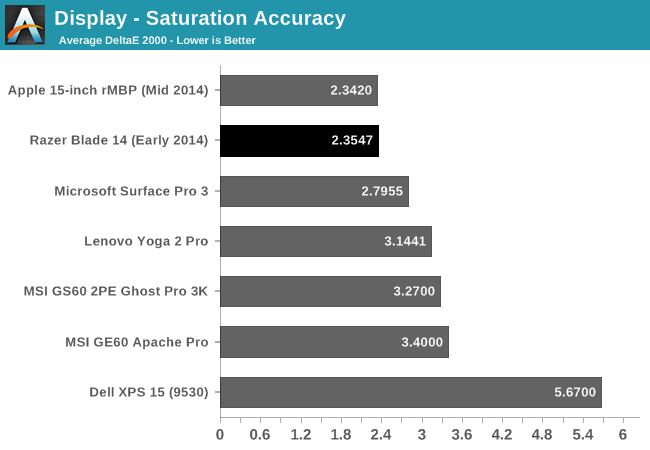

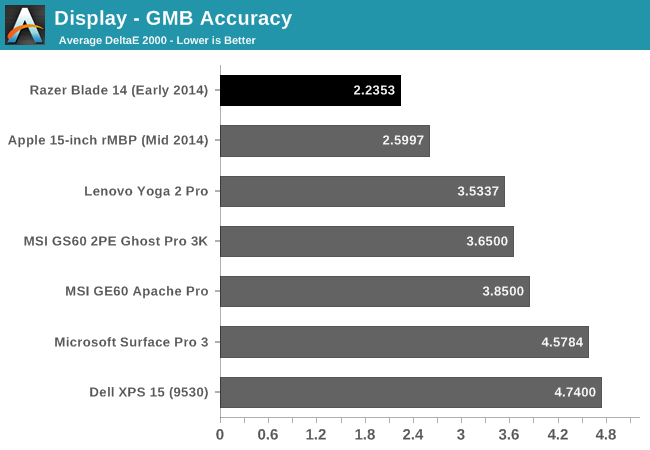

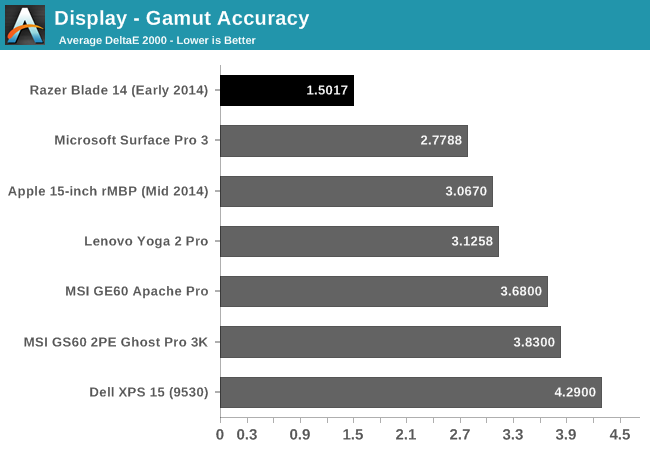

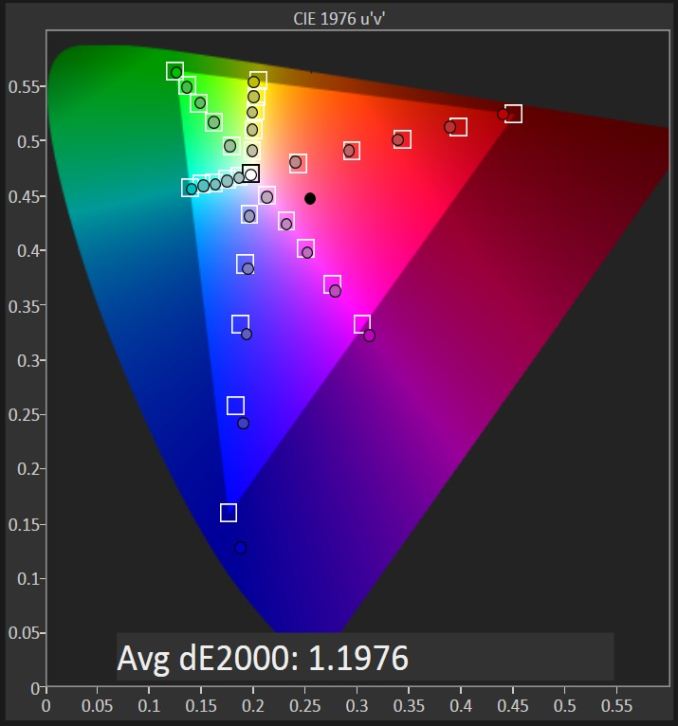










69 Comments
View All Comments
Notmyusualid - Saturday, October 11, 2014 - link
I am a VERY frequent traveller, and I've seen a few Alienware backpacks as I go through airports.I carry my M18x R2 with me everywhere I go, and yes it is heavy, but they are made for adults, right?
Every customer I meet is fascinated to meet my Alienware machine, and it is a great talking point when meeting new customers.
And what is with your 2hrs of battery life? Are you not aware we have integrated graphics, on a 96whr 12-cell battery? Imagine how long that lasts...
If you think there is an image problem associated with these machines, I'd quite enjoy you expressing that opinion to my face... whilst demonstraiting what machine you carry around.
Connoisseur - Saturday, October 11, 2014 - link
I thought it's fairly obvious I carry around a Razer Blade 2014. Listen, I'm not here to get into a laptop beat down contest and I'm a little confused as to why you want me to say anything to your face. I'm not insulting your family, merely your commentary on why people shouldn't be buying these machines. The markets for the two types of machine are very different. Alienware is marketed to and has the reputation of being a college gamers machine; it's always been this way. Their design language and form factor scream "Look at me! I'm sparkly and huge and look like a sci-fi tank!" I used to build systems like that back in college which had LED's with cases that had crazy angles. As I aged, my tastes changed and I preferred something that looks more subtle and slimmer. My wife would make endless fun of me if I carried that monster around.If you're comfortable toting around 15lbs total of computer parts (laptop + power brick) and using an 18" screen on an airplane tray or on your lap, more power to you. I prefer something I can tuck under my arm. Not to mention that I frequently have to also carry around my work laptop and the use case for a slim, lightweight gaming system makes a lot of sense.
DPOverLord - Friday, October 10, 2014 - link
Doesn't seem that great. Did they need such a high res screen? For $2k that GPU may not run it well. Make it a 970/980 with the new refresh.Then upgrade the CPU... Also, weight should not go up.
DPOverLord - Saturday, October 11, 2014 - link
Realized this is not new. Stop reviewing 'old hardware' or at least put a spoiler that you're reviewing something that came out months ago. Bit confusing since I was here thinking "wtf is razer doing"zepi - Friday, October 10, 2014 - link
It sure looks nicer than MSI GS60, but is that alone worth the extra cost? Especially when new version of the MSI is just about to come out with GTX 970M...whyso - Friday, October 10, 2014 - link
Love the review but I feel that these notebook reviews need for the games and CPU benchmark sections the CPU and GPU name beside the name of the notebook for quick and easy comparison.Awful - Friday, October 10, 2014 - link
What use case are they actually targeting with that screen resolution? It sure isn't gaming...Morawka - Friday, October 10, 2014 - link
i wonder how a gaming laptop would be if it used Broadwell Core M for very low power dual core performance at 5-10 watt, and devote the rest of the TDP to GPU. This would prevent throttling whene on battery so long as total system draw is under 100W. 100W is about the peak of what laptop batteries can put out.kallogan - Saturday, October 11, 2014 - link
i'd like to see that too a core m 5yxx would run easy at constant full dual core turbo in a notebook chassis even with a very weak cooling, would give enough cpu power and would let the gpu a lot of tdp room !!!! Under 100W with a premium class gpu would be great.But sadly i don't think core m 5yxx are intended to be paired with discrete gpus, only for convertibles tablets and such but we'll see. Later Broadwell cpus it will be.
But as a gamer concerned mostly by cooling and noise and not caring for a premium cpu as long as there is no major cpu limiting i'm definitely for devoting the power to gpus !!!
limitedaccess - Saturday, October 11, 2014 - link
ULV and lower power Intel mobile CPUs (including the new Core-M series) are limited to PCie 2.0 x4 while M/Q CPUs have the a full PCie 3.0 x16 available to them.The only GTX x60m+ class laptop I'm aware of that pairs with a non M/Q CPU was the announced (but not yet released) Alienware 13 with a Haswell-U + GTX 860m. However there was, I believe, some uncertainty regarding whether that will be the actual CPU configuration.